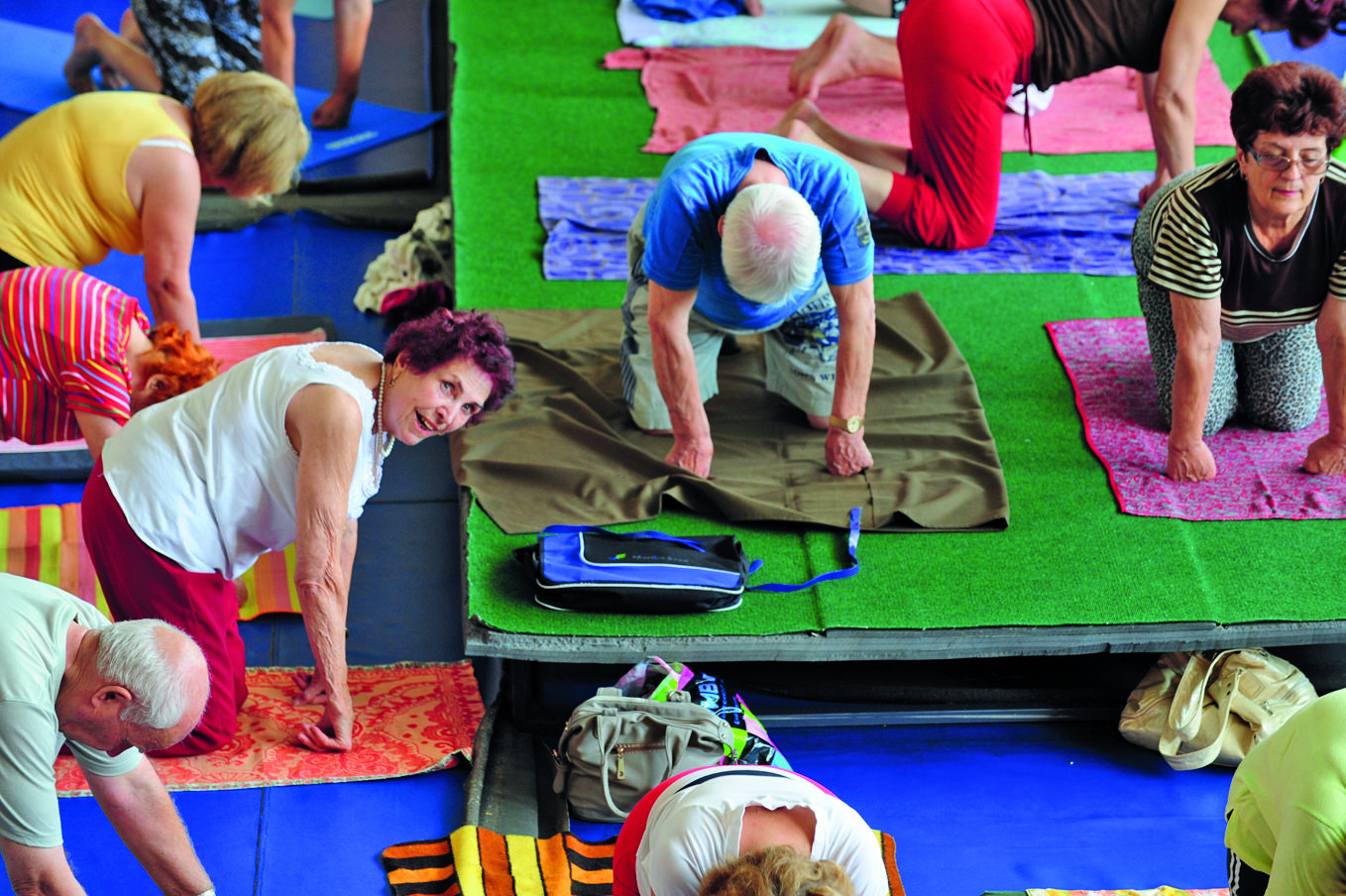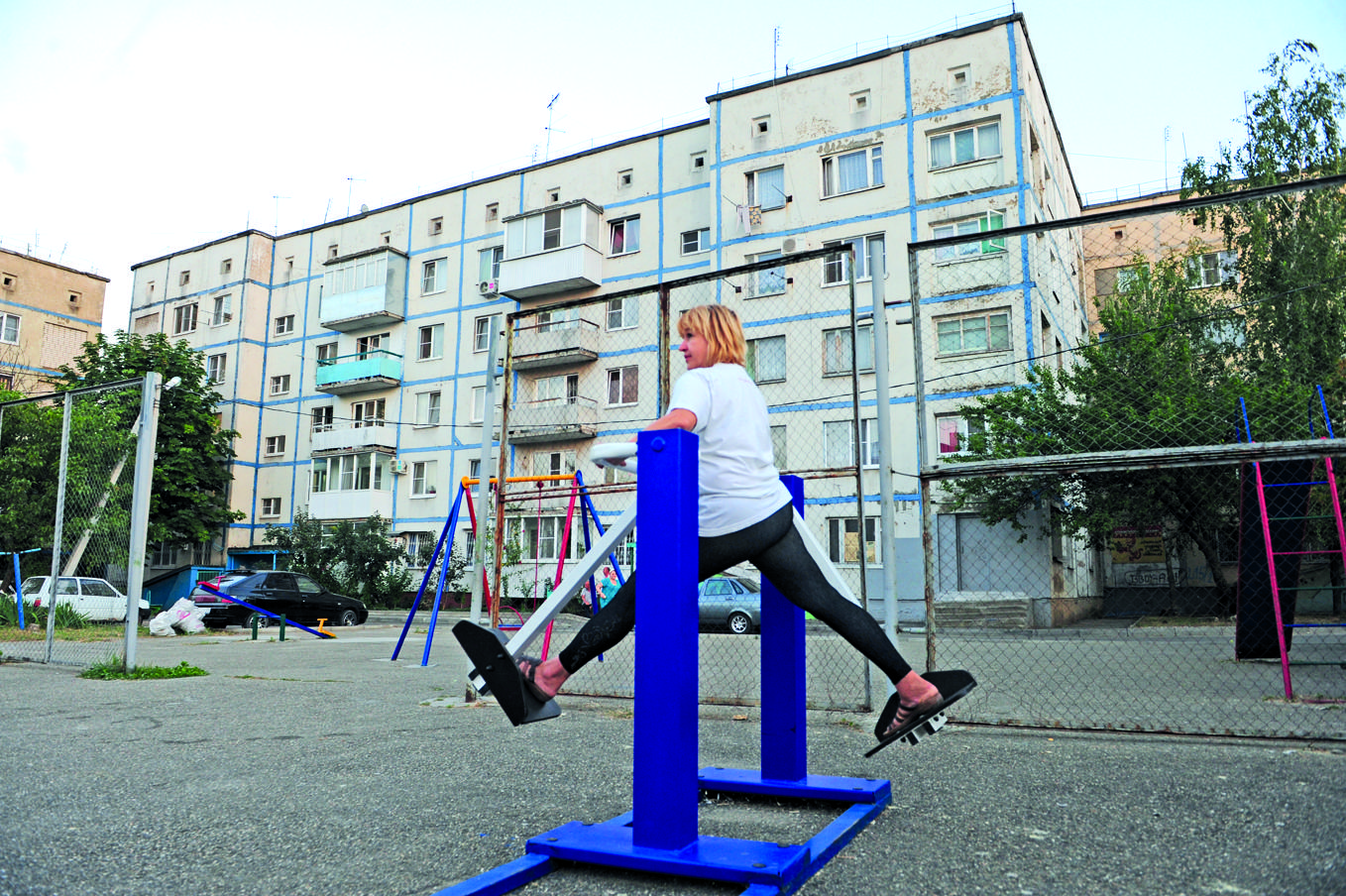Abstract
Stavropol is one of several cities in the Russian Federation that is promoting healthy lifestyles to tackle the epidemic of chronic diseases. Victoria Ivleva reports.
For 88-year-old Zoya Marinich, who lives in the south-western Russian city of Stavropol, the turning point came with a phone call.
“I was invited to meet Vasily Skakun, a man who trained 17 world champion gymnasts,” recalls the retired teacher. Seventy-six at the time of the call, Zoya was not planning to take up vaulting, but she was interested in getting healthy again.
Zoya had seen her share of physical hardship, including working hard on a farm as a girl before the Second World War and, during the war, torture as a partisan while the city was occupied from August 1942 to January 1943.
But what had really taken its toll on her health were decades of physical inactivity and unhealthy eating, a combination that resulted in what Zoya calls a “bouquet” of health problems, including heart disease and chronic muscular pain.
Zoya is one of thousands of people in the Russian Federation, a vast country of 141 million people stretching from central Europe to the Pacific Ocean, who have multiple chronic health problems.
Noncommunicable diseases (NCDs) account for an estimated 82% of all deaths in the country. Cardiovascular disease, including heart disease and stroke, accounts for 62% of those deaths – higher than the global average of 48% – while cancer causes almost 15% of them.
To treat her health problems, Zoya had always relied on medicines provided by her doctor, but she was not optimistic. “I realized that I would not survive on pills alone,” she says. Then the telephone rang. One of the classes offered by the Vasily Skakun Academy was yoga, and Zoya Marinich hit the mat.
Skakun's efforts are part of a city-wide drive to reduce the high toll of NCDs. Stavropol is one of about 100 cities in 30 countries across the European Region of the World Health Organization (WHO) that have joined the international Healthy Cities movement.
The initiative, started by WHO's Regional Office for Europe in 1986, aims to promote healthy lifestyles, create healthy living conditions and combat the NCD epidemic in the 53-country region.
“Stavropol is a dynamic member of the Healthy Cities movement in the Russian Federation and in the European network as a whole,” says Dr Agis Tsouros, the director of policy and governance for health and well-being at the WHO Regional Office for Europe.
Stavropol established a Healthy Cities project office in 2006. But, as Dr Karen Amlaev, WHO Healthy Cities campaign coordinator in Stavropol points out, the city has been involved in activities of the Healthy Cities Association since 1996. “It would have been a sin not to do so, since the deputy mayor of Stavropol on social issues was a doctor,” he says, referring to Valentina Muravyova, who is now rector of the Stavropol Medical University.
Amlaev firmly believes that these activities, which are funded by the city authorities and provided free of charge to all, are already making a difference to the population's health.
The main thrust of Stavropol's efforts is to reduce risk factors for NCDs by raising awareness among people of all ages regarding unhealthy behaviours such as smoking and by providing free health services, such as drop-in clinics to measure blood pressure.
The Russian Federation has one of the highest smoking rates in the world, at around 40%, and each year an estimated 398 000 Russian citizens die from tobacco-related causes, according to the WHO global report: mortality attributable to tobacco – the equivalent of the entire population of the city of Stavropol.
The Healthy Cities campaign is reaching children by distributing a comic with anti-tobacco messaging. It has been such a success that it is now in its fourth edition.
The involvement of local media has been central to the campaign, including interviews with health experts on local radio stations and a regular column in Vecherny Stavropol, a local evening newspaper on health issues.
To promote healthy lifestyles, the city is pursuing a programme of motivational campaigns, including competitions and prizes. There is a “Stop High Blood Pressure!” campaign, for example, and a “Lose those Extra Kilos!” campaign, in which participants have their body mass index measured.
Smoking has also been targeted with a campaign called “Quit and Win” and a competition for schools, in which 14-year-olds compete for six months by educating children in lower grades about the risks of smoking.
At the end of the six months, medical staff and a representative from the city education authorities use breath monitors that check carbon monoxide levels to test whether they or their participants have been smoking. “The winner – the one with the best results – gets a fantastic prize for children: a trip to another city,” Amlaev says.
As of this summer, Stavropol's anti-smoking efforts are getting support from a national anti-tobacco offensive enshrined in a tough new law. Since 1 June, smoking has been banned in many public places and more provisions come into force next year.
One of the world's toughest anti-tobacco laws, it was signed by President Vladimir Putin and has the explicit backing of Prime Minister Dmitry Medvedev, both of whom are non-smokers. But as Larissa Denezhnaya, a 53-year-old journalist with the Vecherny Stavropol newspaper, points out, smoking is deeply rooted in the culture.
“In our country, cigarettes are referred to as ‘food'. I used to think that was right,” says Larissa, who started smoking as a student in the nearby city of Rostov-on-Don.
“In our country, cigarettes are referred to as ‘food'. I used to think that was right.”
Larissa DenezhnayaShe tried to give up several times, but it was only when she ran the “Quit and Win” competition for her newspaper that she realized the absurdity of her own position. “It seemed crazy to be telling people not to smoke and to continue smoking myself,” she says.
Larissa Denezhnaya tries one of the work-out machines at a new free outdoor sports facility near her home
Stavropol even has its own special calendar of events as part of its Festival of Health. This festival involves prize awards for the healthiest class, the healthiest workforce, the healthiest family, the best health programme or publication about health and the healthiest meal and these competitions take place throughout the year. The climax of the city's Festival of Health is an annual event to mark World Health Day on 7 April.
Amlaev believes that one of the strengths of Stavropol's health campaigns is that, in addition to the awareness raising and motivational aspects, it serves a monitoring and diagnostic function.
“The last time we did the blood pressure campaign, about 400 people discovered that they were hypertensive,” he says of the condition that is a major risk factor for heart disease and stroke, but that without regular check-ups can remain undetected for years.
He says that Stavropol was making progress in health-service provision, noting that in the past five years more than 10 000 adults and children have attended specially designated health centres for free check-ups, including blood pressure and blood sugar levels (to diagnose diabetes).
There has also been significant investment in refitting Stavropol's school canteens so that they can prepare food in a more healthy way, for example, by steaming rather than frying.
Above all Amlaev believes that the various campaigns have to be seen in terms of a multi-sectoral approach to tackling NCDs, an approach that includes creating more green spaces in the city and ensuring that people of all ages come together in healthy recreation, whether it takes the form of singing, dancing or yoga.
“An active lifestyle is effective for reducing hypertension and social inclusion has a very strong effect on people's health and well-being,” Amlaev says.
“An active lifestyle is effective for reducing hypertension and social inclusion has a very strong effect on people's health and well-being.”
Karen AmlaevZoya Marinich certainly believes it. Through her yoga practice at the Skakun Academy she now connects with a membership that is a thousand strong, engaged in a variety of healthy pursuits, including yoga, drawing and dance.
Zoya has also changed her diet, cutting back on her consumption of red meat and eating oatmeal porridge for breakfast. And, as for her health, she says she now only sees doctors when she stays at a sanatorium – a benefit she enjoys as a war veteran – adding, with a smile: “They tell me there I look much younger than I am.”

 WHO/Victoria Ivleva
WHO/Victoria Ivleva WHO/Victoria Ivleva
WHO/Victoria Ivleva